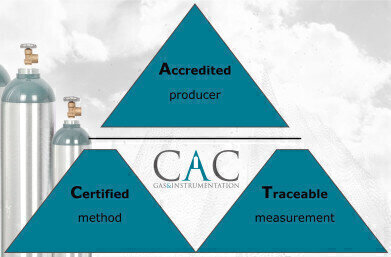Laboratory Products
What makes a good calibration gas?
Sep 07 2020
There are two types of measurements made when preparing gas mixtures. The first is measuring what goes into the cylinder (volumetric or gravimetric measurement), and the second is measuring what comes out of the cylinder (measurement based on analysis). The first is relatively simple, as you need to only have:
- a calibrated pressure or flow device (volumetric)
- a calibrated balance (gravimetric)
The second, analysis-based measurement, is much more involved. It requires a gas analyser and several reference gas mixtures. The type of analyser, operator skill, quality of reference materials and accreditation of the process can each influence the quality of the gas mixture. Analytical results could be referred to as measurement uncertainty or analytical accuracy. If your gas mixture certificate does not give specific information of the methods used ask the manufacturer for the relevant information.
The best quality gas mixtures will be manufactured gravimetrically and analysed with an accredited process, all clearly outlined on the cylinder certificate.
Many reference standard certificates will simply state blanket uncertainties, uniform across all components. The characteristics of each compound in the mixture make it impossible for each component to have the same uncertainty. The values are often based on measurements taken during the manufacturing process and uncertainties based on factors including historical data, uncertainty in weights & balances, or pressure/flow measurements. The process from which the uncertainties have been derived is often vague and unclear.
CAC GAS offers specialty gas & liquid mixtures which meet the highest standards for quality. They are classified into one of three categories based on how they are made, tested, analysed, or certified.
Traceable
Mixtures manufactured using traceable weights and measures. This means that no matter what method is used to manufacture the mixture, the instrumentation (scales/balances, mass flow controllers, pressure gauges, etc.) has undergone a traceable calibration. Traceability requires that the calibration of the instrumentation be ISO17025 certified. Calibration certificates for relative instruments are kept on file and referred to on the mixture certificate if required. This shows an unbroken chain of measurements or calibrations all the way to the accepted international primary reference materials.
Certified
Mixtures manufactured, analysed or tested by specific, documented methods and come with a certificate stating the method(s) used. Such methods may be required by industry, regulatory bodies or internal site standards. These methods exist to promote similar product quality and properties for a single product type from various manufacturers or to ensure a minimum product quality. Methods include those such as ASTM, ISO, or US EPA.
Accredited
Mixtures produced or calibrated within the scope of an ISO17034 or ISO17025 accredited organisation. Accreditation proves the producer’s technical capability in measurement, and stated traceability to SI units, having been thoroughly assessed by the relevant national testing authority. All CAC GAS Accredited mixtures will be made by a producer whose accreditation is recognised under the ILAC MRA, so they are accepted globally. These mixtures meet the requirements of:
- ISO/IEC17025:2017
- ISO Guide 30:2015 (Clause 2.1.1 or 2.1.2)
- AS2290:2018
Digital Edition
ILM 49.5 July
July 2024
Chromatography Articles - Understanding PFAS: Analysis and Implications Mass Spectrometry & Spectroscopy Articles - MS detection of Alzheimer’s blood-based biomarkers LIMS - Essent...
View all digital editions
Events
Jul 28 2024 San Diego, CA USA
Jul 30 2024 Jakarta, Indonesia
Jul 31 2024 Chengdu, China
ACS National Meeting - Fall 2024
Aug 18 2024 Denver, CO, USA
Aug 25 2024 Copenhagen, Denmark

-(1)-(1).jpg)


24_06.jpg)













